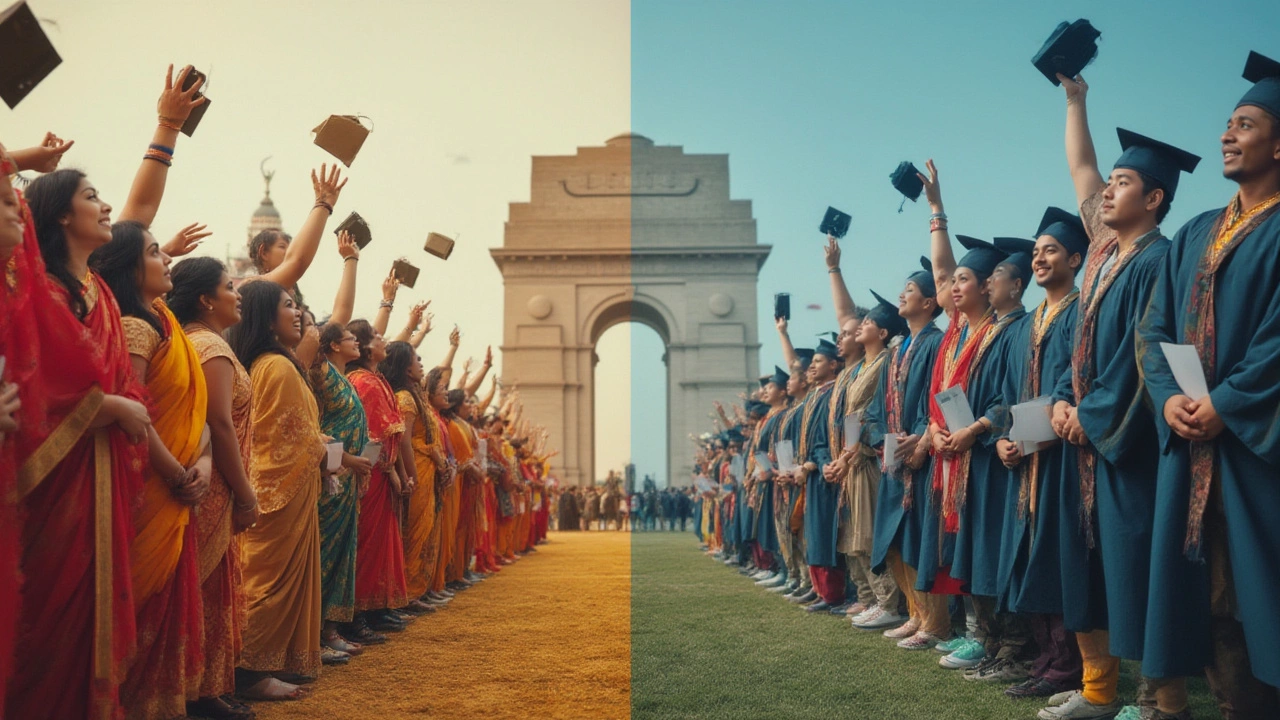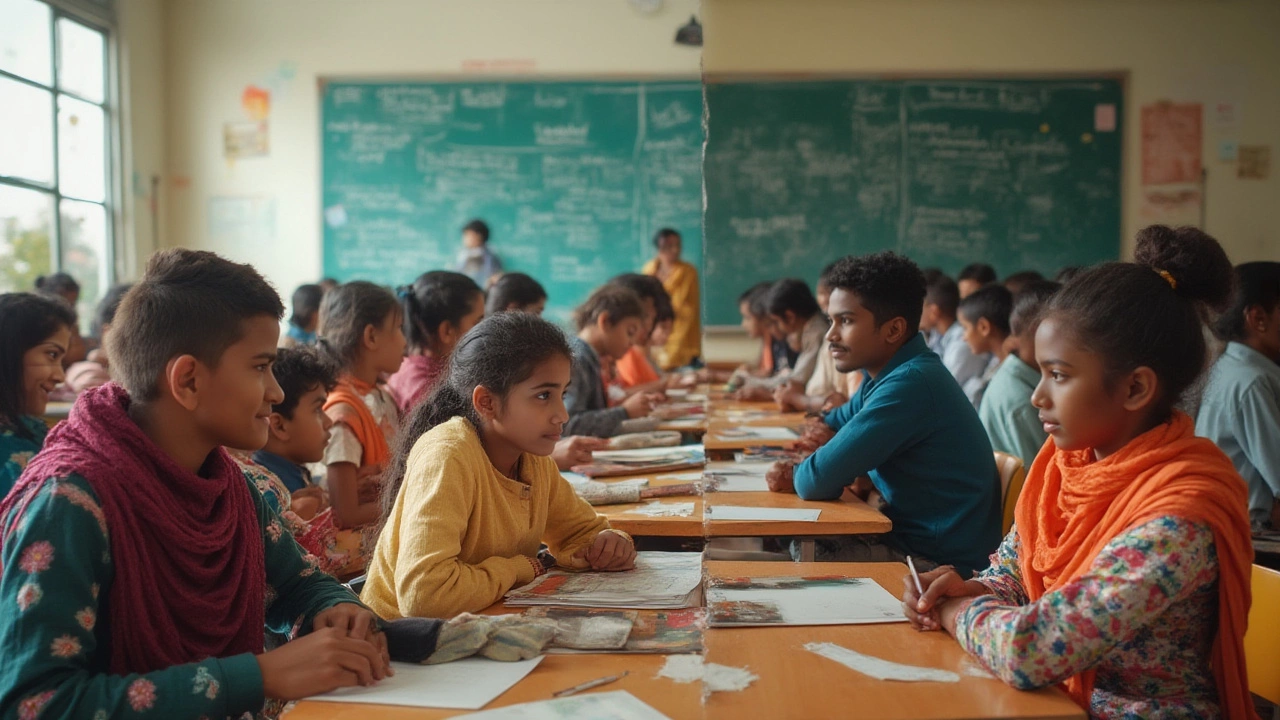Walk up to any parent meet in New York or Mumbai and the usual war stories pop up—homework battles, the admissions circus, who's got the right 'system'. Some families even move whole continents because they believe one school system gives their kid a better launch pad. So who's actually ahead in the race—USA or India? The answer isn't as black-and-white as a grade sheet, and once you dig in, the surprises just keep coming.
Learning by Memory vs. Learning by Doing
Ask any kid in India about what school feels like, and you’ll probably hear about thick textbooks and piles of notes. The CBSE, ICSE, or state boards love exams and fact-heavy syllabi. Students memorize everything from ancient history dates to impossible formulas. There’s a lot of discipline and routine. While rigor has its place, sometimes the creativity goes out the window. Rote learning gets you a long way, but when you put two Indian students head-to-head with a tough, open-ended problem or expect them to lead discussion, some freeze up.
Flip over to the USA, and the classrooms feel like a different planet. The focus is on conversation, projects, and asking questions—even ones that stump the teacher. Kids get to work in groups, make models, and try experiments. The system wants students to connect ideas, not just spit back answers. A fifth-grader might stand up and challenge their teacher, and no one bats an eye. Access to equipment—science labs, art rooms, computers—is baked into the system, which means a student’s imagination can run wild. But it’s not all perfect. Loose rules can mean some kids aren’t pushed as hard. Standardized tests like the SAT try to level the field, but critics argue they don’t measure real potential.
Here’s the twist: Indian students at top US colleges often crush exams and finish projects faster than local students, all because they’re already hard-wired for long hours and dense material. But do they have the same instinct to think out of the box? That’s the ongoing debate. Holidays are another story—with around 200 school days in India but many more breaks in smaller US districts, time spent learning can really differ for students on each continent.
The Numbers Game: Stats That Paint a Real Picture
The stats throw up stories you don’t always expect. Let’s line up some of them:
| Country | Primary Enrollment (%) | Secondary Graduation Rate (%) | Avg. Teachers per 1000 Students | Global University Rankings (Top 100) | Public Education Spending (% GDP) |
|---|---|---|---|---|---|
| USA | 99 | 88 | 15 | 18 | 5.0 |
| India | 95 | 63 | 4 | 0 | 3.1 |
See the gap already? While nearly every US kid is in school (and graduates secondary school) by law, India struggles with kids dropping out—especially girls, rural students, or poorer families. Budget for education paints another story: the USA puts nearly 5% of its GDP into public education, while India lags behind, often under 3.2%. Now jump into rankings, and you’ll spot 18 US universities in the world’s top 100. India has none. That drives a whole migration of top students flying out of India every year.
But don’t write off India as just playing catch-up. The country churns out more engineers each year than the USA, China, and Russia combined—over 1.5 million. When Silicon Valley bosses—like Sundar Pichai (Google) or Satya Nadella (Microsoft)—come from Indian schools, clearly something is working. The tech and math backbone is strong, even if the creative arts and sports lag behind.

Pressure, Competition, and Student Life
The pressure cooker vibe is impossible to ignore. In India, it’s fierce. Competition for top colleges—think IITs, AIIMS—is so wild that students often start 'coaching' from age 12. Some sleep just 5 hours a night. Entrance tests like JEE or NEET see around 2 million applicants fight for a few thousand seats. Failing isn’t just an academic hiccup—it hits family pride, sometimes mental health. Some students sacrifice sports, art, and childhood itself just to notch up exam scores.
In the USA, there’s pressure, but it’s spread out. Sure, Ivy League acceptance rates are lower than some lotteries, and AP courses can leave kids frazzled. But students can mix football with math, or theater with robotics. Grades, test scores, leadership, and volunteering all feed into the college admissions machine. If things go sideways, there are ‘community colleges’ or a chunk of universities willing to give second chances. School counselors, mental health services, and afterschool clubs try to keep students afloat.
Is this American well-roundedness softening genuine excellence? Not really. But it means both the high-flying future scientist and the aspiring artist can find a place. In India, the focus is much tighter. Gifted kids with top grades soar, but late bloomers or students without stellar marks often struggle to stay in the game.
Access, Equity, and the Money Question
Let’s talk money and opportunity. In the USA, public schools are meant to be free and open to all. But property taxes fund schools—so wealthy neighborhoods get great schools with iPads and language labs, while poorer districts sometimes struggle with crumbling buildings and textbook shortages. Around 10% of US kids attend private or charter schools, hoping for an edge.
India has a split right down the middle. Prestigious private schools and international boards (like IB, IGCSE) offer global-level teaching and English fluency. Fees can match US community colleges. But over 70% of Indian students still study in government schools, where the teacher-student ratio can be as bad as 1:60, and basic facilities (water, toilets, computers) are often lacking. Urban kids often zip ahead, while their rural peers race to catch up. Scholarships exist, but massive inequality means plenty of kids fall through the cracks, especially girls or children with disabilities.
There’s been a recent drive in both countries to improve digital learning. The USA rolled out Chromebooks and Zoom classes during the pandemic, but kids without WiFi fell behind overnight. India faced even bigger gaps—millions of children couldn’t join remote classes at all. Yet, India’s EdTech startups (like BYJU’S and Vedantu) exploded, sometimes reaching far-flung villages once left off the education grid.

What Does Success Mean? Why the Answer Isn’t Simple
If you want a straight answer—Is education in the USA better than in India?—get ready for a letdown. It depends what you value. The US system rewards curiosity, independence, and all-round growth. Many American students are comfortable voicing opinions, working collaboratively, and turning ideas into action. But they sometimes lag in hard math or science when compared to their peers in Asia, as shown in PISA rankings where US 15-year-olds rank behind several countries in math.
India’s system raises students who can juggle huge syllabi and ace standardized tests. That explains Indian excellence at spelling bees, global math contests, and high-stakes exams everywhere. It also teaches grit. But public schools in remote areas struggle, and millions don’t make it to graduation.
My daughter Eliora is growing up watching both systems. She loves the lively debates in American classrooms and the math puzzles I bring from my Indian childhood. Would I want her to swap curiosity for cramming? Not a chance. But I’d like more rigor in American math, and more music and debate in Indian schools. The holy grail might just be a system blending both: the confidence and curiosity of the US approach, and the resilience and determination baked into the Indian model.
So, is one system better? Maybe for some. For others, it’s about grabbing the best bits—no matter what side of the world you wake up on.
